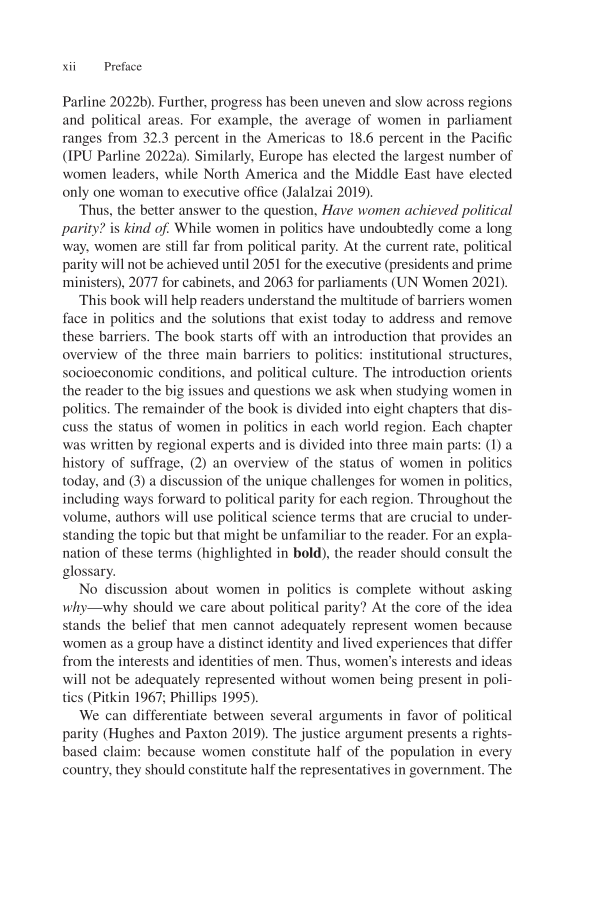xii Preface Parline 2022b). Further, progress has been uneven and slow across regions and political areas. For example, the average of women in parliament ranges from 32.3 percent in the Americas to 18.6 percent in the Pacific (IPU Parline 2022a). Similarly, Europe has elected the largest number of women leaders, while North America and the Middle East have elected only one woman to executive office (Jalalzai 2019). Thus, the better answer to the question, Have women achieved political parity? is kind of. While women in politics have undoubtedly come a long way, women are still far from political parity. At the current rate, political parity will not be achieved until 2051 for the executive (presidents and prime ministers), 2077 for cabinets, and 2063 for parliaments (UN Women 2021). This book will help readers understand the multitude of barriers women face in politics and the solutions that exist today to address and remove these barriers. The book starts off with an introduction that provides an overview of the three main barriers to politics: institutional structures, socioeconomic conditions, and political culture. The introduction orients the reader to the big issues and questions we ask when studying women in politics. The remainder of the book is divided into eight chapters that dis- cuss the status of women in politics in each world region. Each chapter was written by regional experts and is divided into three main parts: (1) a history of suffrage, (2) an overview of the status of women in politics today, and (3) a discussion of the unique challenges for women in politics, including ways forward to political parity for each region. Throughout the volume, authors will use political science terms that are crucial to under- standing the topic but that might be unfamiliar to the reader. For an expla- nation of these terms (highlighted in bold), the reader should consult the glossary. No discussion about women in politics is complete without asking why—why should we care about political parity? At the core of the idea stands the belief that men cannot adequately represent women because women as a group have a distinct identity and lived experiences that differ from the interests and identities of men. Thus, women’s interests and ideas will not be adequately represented without women being present in poli- tics (Pitkin 1967 Phillips 1995). We can differentiate between several arguments in favor of political parity (Hughes and Paxton 2019). The justice argument presents a rights- based claim: because women constitute half of the population in every country, they should constitute half the representatives in government. The
Document Details My Account Print multiple pages
Print
You have printed 0 times in the last 24 hours.
Your print count will reset on at .
You may print 0 more time(s) before then.
You may print a maximum of 0 pages at a time.





































































































































































































































































































































